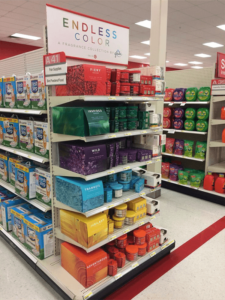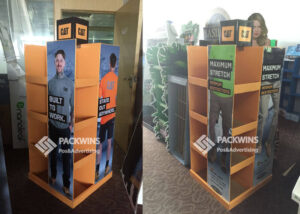POP (Point-of-Purchase) displays are an effective marketing strategy because they capture shopper attention at the decision-making moment, reinforce brand messaging, and influence impulse purchases. Especially when made from corrugated cardboard, POP displays offer cost-effective, customizable, and sustainable solutions that increase product visibility and drive sales in retail environments.
1. What a POP Display Is — and Why It Matters
A POP (Point‑of‑Purchase) display is essentially any retail marketing fixture placed at or near the point of sale (or along the aisle) with the goal of capturing shopper attention, promoting a product, and influencing the purchase decision. These are distinct from standard shelving because they are often temporary, highly branded, and optimized for visual impact.
In today’s retail landscape, where shelves are crowded and shoppers are time‑pressured, a POP display gives a brand the opportunity to stand out from commodities. Because so many purchase decisions happen in‑store, these displays matter. Research by POPAI shows that approximately 76% of all purchase decisions in mass‑merchandisers are made in‑store.
Corrugated cardboard displays carry this advantage further because the material allows for creative structural elements: die‑cuts, 3D headers, unusual geometry, flat‑pack shipping, and easy assembly. In other words: they let brands be bold and retail‑friendly at the same time.
For example, instead of a standard rectangular stand, you might build a curved shelving unit that matches your brand’s logo shape or a tiered dump‑bin that invites grabbing. That extra structural dimension makes the display more than just a product holder—it becomes a mini brand experience.
2. Capturing Attention In Store: The Visual and Structural Advantage
Shoppers spend only seconds scanning products. A well‑designed POP display does several things:
- It interrupts the visual noise of the aisle.
- It draws the eye through shape, color, and positioning.
- It elevates perception of the product through design.
Studies by POPAI and other retail marketing groups show that displays have strong influence. For instance, one blog notes: “In‑store displays have increased sales by up to 65% when POP/POS materials are used.”
Corrugated cardboard displays further this advantage because their structural flexibility allows creatives to push boundaries. With cardboard you can create bold headers, printed graphics on multiple planes, cut‑outs, and even interactive elements—without the heavy cost or permanence of metal/acrylic fixtures.
Some practical design‑tips for attention:
- Use bold, brand‑consistent colors that contrast with surrounding shelf space.
- Employ dramatic header or shape elements that rise above the typical shelf line.
- Position displays at eye‑level or in high‑traffic zones (such as endcaps or checkout islands) to maximize exposure.
- Ensure clear branding and messaging so the display tells a story in under 3 seconds.
3. Converting Browsers into Buyers: Location, Messaging & Interaction
It’s one thing to be seen; it’s another to convert. POP displays help turn browsing into buying through a combination of placement, messaging, and interaction.
Placement: Best practice shows that displays near the high‑traffic zones (endcaps, front of store, checkouts) generate the highest impact. One study by Frank Mayer & Associates stated that “six out of ten retail purchases are classified as impulse buys… customers also prove they’re open to in‑store influences so that brand owners increase sales with pop displays.”
Messaging: Clear, simple calls to action (“New! Try me!”, “Limited Time Offer!”, “Grab & Go”) work best. The instant the shopper understands what the display is offering, you eliminate need for extra thought.
Interaction: Displays that invite touch, grabbing, or sampling amplify the conversion effect. Corrugated displays lend themselves to open shelving, accessible product placement, and interactive add‑ons (for example, a QR tag or freebie flyer) without heavy cost.
Moreover, research highlights how presentation matters. According to a blog on “Effective In‑Store Display Strategies”, one study found temporary POP displays delivered an average 24% sales lift during campaigns.
For example: A snack brand sets up a tiered cardboard dump‑bin at the front of store with “New flavour” signage and free sample. Because of prime placement + clear callout + easy access, browsers try it, like it, buy it. The display did the job of persuasion.
4. Brand Reinforcement at Shelf Level
Every time a shopper passes a shelf or display, you’re competing for memory, recognition, and emotional connection. POP displays amplify brand messaging beyond packaging.
With corrugated cardboard as your canvas, you can:
- Use full‑wrap graphics rather than simple panel printing.
- Incorporate brand tone, taglines, iconography, even product storyboards onto the display.
- Match your seasonal or campaign visuals at scale with lower cost.
When your display echoes your broader marketing‑campaign visuals—online, print, social—you unify the shopper’s experience. That makes your brand more memorable, more trusted, and more likely to be chosen.
Plus, many retailers appreciate displays that are turnkey, clean, and visually impactful—because they support their store brand while enhancing yours. A custom cardboard display can give a brand premium shelf presence without the cost of heavy fixtures.
5. Flexibility for Promotions, Seasons & New Products
One major advantage of corrugated POP displays: they adapt. Whether you’re launching a new product, running a seasonal promotion, or testing a campaign in limited stores, these displays give you flexibility to iterate and pivot.
Examples of flexibility:
- A beverage brand launching a summer limited‑edition flavor uses a beach‑themed cardboard floor display for three months, then transitions it to a new “back to school” motif.
- A snack brand runs a Halloween campaign with grave‑yard graphics and then reuses the same structural unit with different artwork for holiday.
- A testing brand sends a smaller display to select stores to evaluate performance and replicates only if sales metrics justify full rollout.
Because corrugated displays are less expensive to design, print, ship and install compared to permanent metal or acrylic fixtures, you are freer to experiment—and that experimentation often leads to better results and more creative campaigns. The blog from Frank Mayer & Associates underscores this: “Custom retail displays… for short‑lived promotions or seasonal products. According to a 2024 survey by Mood Media, 58 percent of shoppers notice in-store displays.
6. Measurable Results & ROI: Why the Investment Makes Sense
The best marketing spends are those you can measure. Thankfully, POP displays now have real metrics behind them.
According to POPAI and other studies:
- In the 2012 Grocery Channel report, the in‑store decision rate climbed to 76%.
- Displays with brand present resulted in estimates of one in six purchases being influenced by them.
- One blog notes that POP/POS materials can increase in‑store sales by up to 65%.
- Another whitepaper shows baseline lifts between 2.6% and 45.5% depending on category and execution.
With that kind of data, a well‑executed corrugated POP display becomes not just a creative asset—but a measurable marketing investment. The lower cost of cardboard structure further improves the ROI.
Consider: flat‑pack shipping reduces logistics cost; simpler assembly reduces labor cost; recycled/yet‑premium materials reduce material cost and appeal to sustainability‑driven buyers. That means you get more marketing bang for your buck.
In addition, measuring metrics such as sales lift, dwell time, units per transaction and average transaction value (ATV) helps brands refine their display programs.
7. Sustainability & Cost‑Effectiveness: Corrugated Cardboard’s Dual Advantage
In today’s retail ecosystem, sustainability matters nearly as much as performance. Corrugated cardboard POP displays hit the sweet spot between eco‑conscious design and marketing effectiveness.
- They’re recyclable and can be made from post‑consumer recycled content.
- They ship flat—reducing carbon footprint and logistics cost.
- They lend themselves to zero‑waste end‑of‑life, aligning with retailer and brand environmental goals.
- Tools such as POPAI’s environmental calculator (“Sustain®”) help brands evaluate and demonstrate the impact of their display strategy.
From a cost‑perspective, corrugated POP displays are often a fraction of the cost of custom metal/acrylic units. That makes them accessible not only to big brands but also to mid‑size and emerging brands—helping you compete visually in‑store.
And from a brand reputation perspective, using sustainable materials sends a signal to retailers and modern consumers alike.
8. Integrating POP Displays Into Your Broader Marketing Strategy
A POP display should not operate in isolation—it’s part of the omni‑channel shopper journey. Here’s how to integrate intelligently:
- Align visuals: Use the same graphics, colors, and campaign hashtags that you use in social media, print, and e‑commerce.
- Leverage timing: Launch the display at or immediately after your digital campaign so the shopper recognizes the message on shelf.
- Use data: Measure the impact of the display (sales lift, foot traffic, units sold above baseline) and feed those insights into your next campaign.
- Make it retailer‑friendly: Provide retailer execution guidelines (placement, signage, easy flat‑pack assembly) and ensure compliance so your display works as intended. According to one source, “effective POP display programmes help create urgency among shoppers… generating immediate increase in basket size.”
- Plan for refreshes: Because cardboard is cost‑effective, plan seasonal refreshes or messaging updates to keep the display fresh and relevant.
By doing so, the display becomes a touchpoint in the entire purchase funnel—linking awareness to consideration to conversion, and tying in‑store retail to your brand’s overall story.
At your company, you specialise in guiding brands through structural design, prototyping, production, and shipping of custom corrugated POP displays. If you’re ready to turn shelf space into brand space, let’s talk.
Conclusion: Why POP Displays Continue to Win
In a retail era of endless digital ads, online comparison, and mobile‑driven traffic, there remains one place where the purchase decision often happens: in‑store. A POP display that is well‑designed, well‑placed, well‑executed becomes a key lever in your marketing strategy.
Corrugated cardboard displays add significant value to that strategy: cost‑effective, flexible, sustainable, structurally customisable, and measurably effective. As you plan your next product launch, seasonal promotion, or brand refresh, ask not just “Should we do a POP display?” but rather “How can we design a POP display that amplifies our brand, drives conversion and integrates into our marketing ecosystem?”
At Packwins, you specialise in helping brands create custom corrugated POP displays that do exactly that — turning concepts into retail‑ready, high‑impact visual merchandising platforms.



